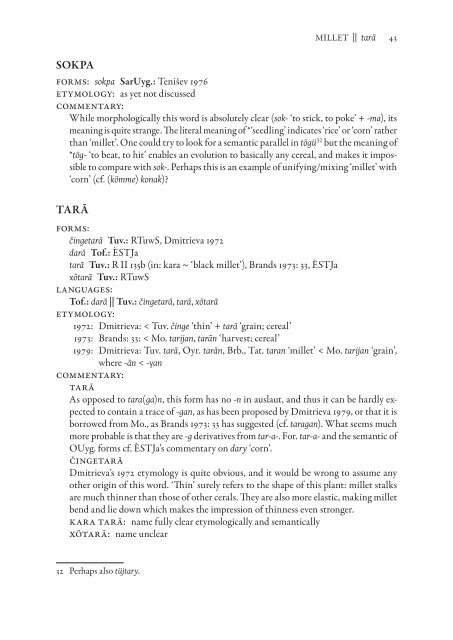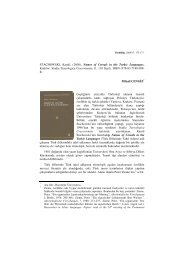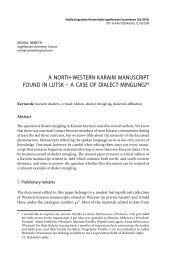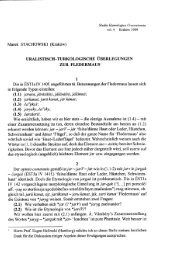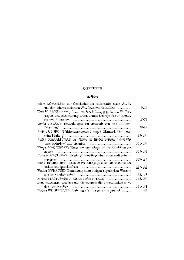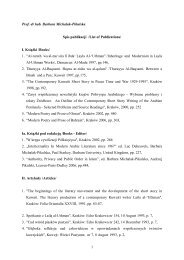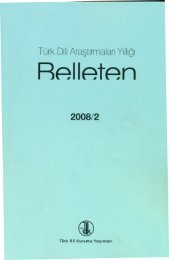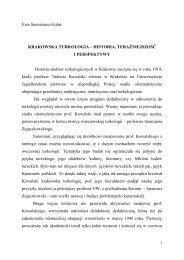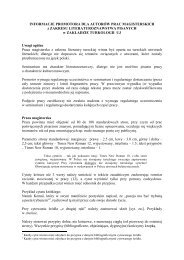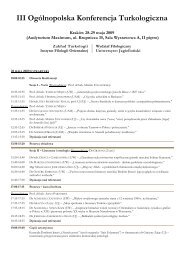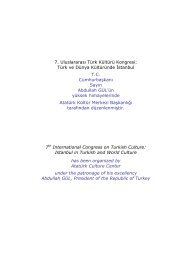Names of Cereals in the Turkic Languages - Wydział Filologiczny UJ
Names of Cereals in the Turkic Languages - Wydział Filologiczny UJ
Names of Cereals in the Turkic Languages - Wydział Filologiczny UJ
- No tags were found...
Create successful ePaper yourself
Turn your PDF publications into a flip-book with our unique Google optimized e-Paper software.
Millet || tarā 43sokpaforms: sokpa SarUyg.: Tenišev 1976etymology: as yet not discussedcommentary:While morphologically this word is absolutely clear (sok- ‘to stick, to poke’ + -ma), itsmean<strong>in</strong>g is quite strange. The literal mean<strong>in</strong>g <strong>of</strong> *‘seedl<strong>in</strong>g’ <strong>in</strong>dicates ‘rice’ or ‘corn’ ra<strong>the</strong>rthan ‘millet’. One could try to look for a semantic parallel <strong>in</strong> tögü 32 but <strong>the</strong> mean<strong>in</strong>g <strong>of</strong>*tög- ‘to beat, to hit’ enables an evolution to basically any cereal, and makes it impossibleto compare with sok-. Perhaps this is an example <strong>of</strong> unify<strong>in</strong>g/mix<strong>in</strong>g ‘millet’ with‘corn’ (cf. (kömme) konak)?tarāforms:č<strong>in</strong>getarā Tuv.: RTuwS, Dmitrieva 1972darā T<strong>of</strong>.: ÈSTJatarā Tuv.: R II 135b (<strong>in</strong>: kara ~ ‘black millet’), Brands 1973: 33, ÈSTJaxōtarā Tuv.: RTuwSlanguages:T<strong>of</strong>.: darā || Tuv.: č<strong>in</strong>getarā, tarā, xōtarāetymology:1972: Dmitrieva: < Tuv. č<strong>in</strong>ge ‘th<strong>in</strong>’ + tarā ‘gra<strong>in</strong>; cereal’1973: Brands: 33: < Mo. tarijan, tarān ‘harvest; cereal’1979: Dmitrieva: Tuv. tarā, Oyr. tarān, Brb., Tat. taran ‘millet’ < Mo. tarijan ‘gra<strong>in</strong>’,where -ān < -γancommentary:tarāAs opposed to tara(ga)n, this form has no -n <strong>in</strong> auslaut, and thus it can be hardly expectedto conta<strong>in</strong> a trace <strong>of</strong> -gan, as has been proposed by Dmitrieva 1979, or that it isborrowed from Mo., as Brands 1973: 33 has suggested (cf. taragan). What seems muchmore probable is that <strong>the</strong>y are -g derivatives from tar-a-. For. tar-a- and <strong>the</strong> semantic <strong>of</strong>OUyg. forms cf. ÈSTJa’s commentary on dary ‘corn’.č<strong>in</strong>getarāDmitrieva’s 1972 etymology is quite obvious, and it would be wrong to assume anyo<strong>the</strong>r orig<strong>in</strong> <strong>of</strong> this word. ‘Th<strong>in</strong>’ surely refers to <strong>the</strong> shape <strong>of</strong> this plant: millet stalksare much th<strong>in</strong>ner than those <strong>of</strong> o<strong>the</strong>r cerals. They are also more elastic, mak<strong>in</strong>g milletbend and lie down which makes <strong>the</strong> impression <strong>of</strong> th<strong>in</strong>ness even stronger.kara tarā: name fully clear etymologically and semanticallyxōtarā: name unclear32 Perhaps also tüjtary.


